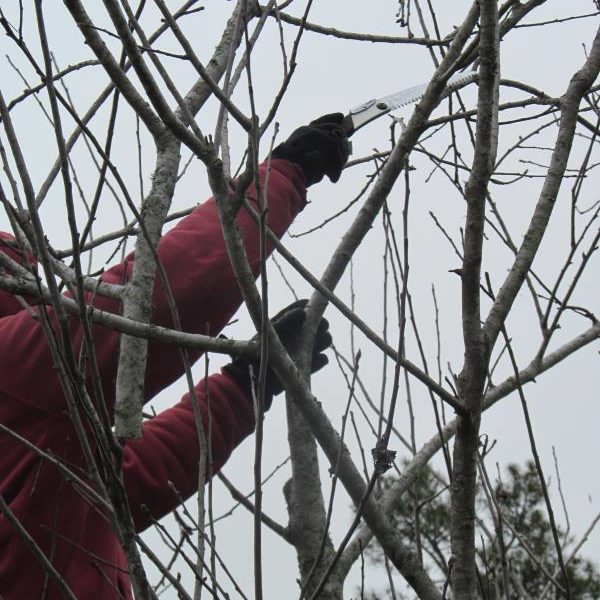
Why Prune at all?
One of the most often asked questions we get at the nursery is; when and how do I prune my fruit trees? The pruning of fruit trees doesn’t need to be confusing, It is not rocket science. If you follow a few simple guidelines it’s easy to keep your trees healthy and productive, and low enough to allow for easy picking.
If left un-pruned, all fruit trees will bear fruit, but the trees will soon become too tall to easily harvest, the fruit will be small and of reduced quality, and the trees will develop a habit of alternately bearing heavy crops one year and light crops the next. All of these problems can be overcome with a little training when the plants are young, and an annual pruning to keep them in shape.
The real secret to pruning is to train your tree from day one rather than waiting until it’s over- grown. The first couple of years of a fruit trees life is spent growing and building structure. Those are the years to be pruning hard to create a simple open frame. Spend a little time learning the correct system to train your fruit tree. Open center and modified central leader may sound like a foreign language to you, but they are systems based on the natural growing patterns of the tree and will work magic on getting your tree to produce well. Read our guide on “Training Fruit Trees” to get the foreign out of these pruning styles.

When to Prune
When to prune is a trickier question, as it will depend a lot on the type of fruit tree you are pruning.  Although most fruits are pruned in late December or January, pruning can stimulate plants to break dormancy, and lead to the bloom being killed in late spring frosts.. A good rule of thumb in our area is to begin the pruning season with the fruits that bloom later, including grapes, kiwi, persimmon, pear and pecan, and save the earlier bloomers, such as peach, plum, nectarine, apple, and figs for late February through March. Pruning at this time insures they hold their dormancy until spring and wounds heal more quickly. If tree-height is a concern, consider doing some light summer pruning. It’s a great way to keep the height of fruit trees in check. Citrus trees are best pruned during the warm season; any time after fruit-set through July. For a complete look at when to prune what refer to the chart at the end of the article.Â
Tips on Getting it Right
– Making a clean cut with sharp pruning shears  and saw helps the tree heal quicklyÂ

-Don’t trim the stub too close to the bud or past the growth collar.
-Trim to the top most bud growing in the direction you want the limb to head.Â

-Remove root-stock suckers. Most fruit trees are grafted; the first 6 to 10 inches of what sticks out of the ground is the root stock. If sprouts are allowed to grow from the root stock, they can quickly overtake and destroy the grafted part of your tree.
 -Clean up the debris that is left from pruning. Burn it, or compost it well away from the orchard, as it can harbor disease and pests that will return to your trees. Also, clean your tools, (shears, pruners, loppers, and saws) between every tree, with household bleach (ex: Clorox): 25% solution (1 part bleach + 3 parts water)  or rubbing alcohol (70% isopropyl): 50% solution (1 part alcohol + 1 part water). The rubbing alcohol mix is less corrosive on your pruning tools.
 Finally, be brave. Many gardeners hesitate to prune as much as needed, fearful of harming their trees, vines, and brambles. But under-pruning can be as bad as over-pruning. So study up: read the IFIS guides, ask your local nursery for pointers, or look for well-maintained plants in your neighborhood and ask the owner for advice. Once armed with information, arm yourself with clean, sharp tools, then get out there and do some pruning.
Finally, be brave. Many gardeners hesitate to prune as much as needed, fearful of harming their trees, vines, and brambles. But under-pruning can be as bad as over-pruning. So study up: read the IFIS guides, ask your local nursery for pointers, or look for well-maintained plants in your neighborhood and ask the owner for advice. Once armed with information, arm yourself with clean, sharp tools, then get out there and do some pruning.
When to Prune Chart

Got a question of pruning your fruits trees? Leave us a comment, we’d love to help.

